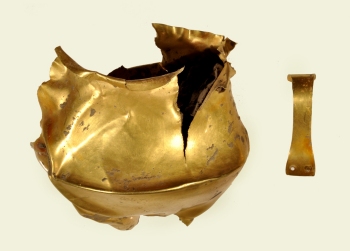The Gold Cup of Montecchio Emilia: a princely Treasure from 3,800 years ago
Finding of the Cup
In March 2012, a routine preliminary archaeological inspection was carried
out inside a gravel pit located along the terraces on the right side of the Enza
River between St. Ilario and Montecchio, in the Township of Montecchio Emilia
(Province of Reggio Emilia). The location was already well-known and considered
to be at “archaeological risk”, thanks to previous archaeological surveys, which
revealed: traces of dwellings from the very late-Neolithic and Bronze Ages
(IV-III millennium B.C), terramara cremation urns from the mid-recent Bronze Age
(XIV-XII centuries B.C.), presumably linked to a known terramara settlement
slightly to the south, and Etruscan graves.
The cup was found on the eastern
edge of the area under scrutiny, in historical age agricultural land, on a strip
of soil connected to the lower margin of recently ploughed land. It had clearly
been lifted up and partially moved by the plough quite some time ago. No
structure, tomb or anything else that could be correlated to the original
resting place of the cup was found: evidently, it must have been buried in a
simple hole in the bare earth. It appears to have been smashed in ancient times,
then later partially broken by a plough, which seems to have pulled out a small
piece.
 Dating
Dating
The form of the cup, characterized by a convex lower part, consists of an
accentuated base with bowed-out concave sides and a flat, ribbon-shaped handle
running from the brim to the bottom. It is quite similar to a well-known form
also seen in ceramic cups: they, too, are typical of the Late European Bronze
Age (Bz A2 – ca 1950-1600 B.C.), present in both the Cisalpine Polada culture
and the Mitteleuropean culture of Aunjetitz/Unetice, with forms like these
extending all the way to the Atlantic coast. The cup is thus easily datable to
around 1800 B.C. in a phase that preceded and formed the better-known Emilian
Terramara Culture.
Comparisons
Cups like the one from Montecchio are very rarely found in Europe due to the
intrinsically high value they have always had: in fact, only four other examples
similar to this one have been found in all of Europe. An isolated cup, similar
to it, with decorated handle and rim, was found by farmer Heirich Sonntag, in
Fritzdorf (Germany: Township of Wachtberg, Rhein-Seig-Kreis, State of Nord Reno-Westfalia)
on November 11, 1954. Restored to its original form, with the compression marks
removed, the cup is now conserved in the Landesmuseum of Bonn. Its dimensions
are quite similar to those of “our” cup – height: 12.1 cm., maximum diameter,
12.2 cm. Average thickness of the lamina 1.3mm, weight 221 grams, composition of
the metal about 79% Au, 19% Ag, 2%Cu. A similar cup was found at Plumilliau in
Brittany, in an Amorican mound, that had been dug up and plundered in the XIX
century. This example is now lost, but, a one spoon in gold lamina associated in
the tomb still remains.
Two cups from the same period in England are on display in the British Museum:
although similar in type to the others, they were modelled in horizontal
ribbing, in part because the laminae are thinner. The Rillaton cup, slightly
higher than 11 cm, was found by stone-workers who were clearing a Neolithic
grave that bore the remains of a male skeleton, a bronze dagger and other items,
underneath a stone burial mound in Cornwall (Bodmin Moor – Rillaton) in 1837;
remodelled after the discovery, the cup and the dagger came to the British
Museum in 1936 from the treasure of the of Dukes of Cornwall. The Ringlemere cup
is very similar to it: in its present condition (flattened down) it is 14 cm
high, indicating that its original height was probably slightly over 12 cm. It
was found in a burial mound at the centre of Tinglemere henge (Sandwich – Kent)
in 2001 by “hunters” using metal-detectors and was handed over for a cash award
as established by the Treasury Act of 1996. The award was set at £270,000 (about
€400,000).
Discovery of the Montecchio Emilia Cup: Context
No other elements - from strictly the same period as the Montecchio cup -
were found in the gravel pit area: it thus must have been hidden away or placed
there as a votive offering, although some information from the archives,
presently under examination, might be able to link the cup to a finding of 13
gold objects, apparently from the Bronze Age, when a field in Montecchio was
ploughed on January 18, 1782: unfortunately, the items were melted down. All
that remains are lively descriptions from the period.
Interpretations
There is still a great deal of discussion among scholars concerning the
significance of these findings: if, in the Atlantic area, gold artefacts like
these were part of particular tombs – of chieftains or priests – being
“liturgical” objects linked to particular functions or rites, items like the
Fritzdorf and Montecchio Emilia cups could be associated with votive depositions
rather than simply places to hide precious objects for reasons of security.
Ongoing Research
The gold cup of Montecchio Emilia has much more to tell us. Meticulous
analysis of the material inside it (before removal) will be able to clarify if
the object had originally been filled with liquid or other substances when it
was deposited. Metallographic analysis can provide information on the origin of
the metal, the techniques used to create it, and on the sequence of steps taken
to render the object useless. Results should be completed by the end of this
year, if funds are available to cover laboratory costs. Once the cup has been
emptied of the material inside, it will be possible to weigh it accurately
verify if, in fact, the thickness of the lamina is slightly thicker than the
other transalpine pieces.